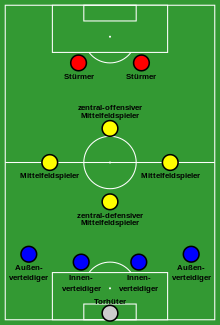midfield player
Midfielder (formerly also runner ) is a playing position in various team sports, for example in football and hockey .
Midfielder in soccer

In football , a distinction is made between the defensive, central and attacking midfielder.
Defensive midfielder
The defensive midfielders in today's lineups replace the pre-stoppers that were popular in earlier times . You take over the post in front of the defense and are responsible for disrupting the opponent's offensive play in such a way that attacks on your own goal are prevented.
In addition to this defensive part, they often have to have qualities in building up the game . They are required to have a large overview and a high level of precision . They also need to be able to quickly identify game situations, for example when a ball has just been won and there is a possibility of a counterattack .
Often times, with reference to standard game systems, the defensive midfielder is referred to as the "six" or the position as "the six". In fact, until a few years ago, players in this position mostly wore the jersey with the number 6. A system with two defensive midfielders is therefore also known as a “double six” . In this variant, one of the two "sixes" can join the offensive, while the second "backs up". The two players can take turns, which makes the style of play more flexible and, if necessary, adapts to the opposing team, should one of the two players get along better with it. The German national soccer team, for example, played in the 2010 and 2014 World Cups and in the 2012 European Championship with the players Schweinsteiger and Khedira as a double-six.
Central midfielder
In many systems, the central midfielder is the interface between defense and attack. Just like the defensive midfielder, he too must conquer the ball, but like a playmaker he must also be able to initiate the attacking game . In addition to the skills required for a defensive midfielder, he must be extremely strong running, as both the defense and the attack are his work area. He often commutes between the two penalty areas and has to travel long distances. It is also known as the “ eight ” , between sixes and tens.
Attacking midfielder
The offensive midfielder is intended for the central attacks of a team and often fills the role of a playmaker . One of his main tasks is preparing and scoring goals. The important thing is that he works together with the defensive midfielders. Without teamwork on the sides, there will be gaps that could easily be used by the opponent to advance. His radius of action often refers to the opponent's penalty area and the area in front of it. He usually has an excellent passing game and a very good overview, which comes from the often very pronounced peripheral vision . The "classic" number of the attacking midfielder is 10 ( "tens" ). In addition, the terms midfield motor, control center or director are used for the attacking midfielder in sports jargon. A typical attacking midfielder was, for example, the three-time world footballer Zinedine Zidane .
Outside midfielder
Their area of activity is the two outer lanes or wings (left or right), their main task is to prepare the goal, for example through flanks. They are often very strong because they have to play the entire outer lane. They are mainly supported by the full-backs who take on the defensive part. The transition from outside midfielder to winger is often fluid.
Midfielder in hockey
In hockey , as in football, a distinction is made between the defensive and offensive tasks of midfielders . The midfielders, who are considered to be the connection between defense and attack, should create a compact team formation in the defensive area, recognize and initiate pressing situations and, if necessary, be able to move to the side close to the ball. On the offensive, depending on the position of the player, the forcing of the game over the outside through runs across the flanks, a safe build-up of the game and pairing with other midfielders to tear holes is required.
Midfielder in handball
In handball there were midfielders only in the days of field handball . There the two midfielders were the connection between the four defenders and the four attackers. They did most of the leg work as they had to switch from attack to defense and vice versa. The specialty of field handball was that only six players were allowed to stay in the respective playing field zones.
Web links
Individual evidence
- ↑ FOCUS Online: Bender or Höwedes for Boateng . In: FOCUS Online . ( focus.de [accessed on October 28, 2018]).
- ↑ SPIEGEL ONLINE, Hamburg Germany: Photo series - Image 2 - In the World Cup qualifier against the Faroe Islands, Löw brings three Dortmunders. Retrieved October 28, 2018 .
- ↑ Armin Burkhardt: German football and its language. Retrieved October 28, 2018 .
- ↑ Tactics - Training Requirement of the game positions in the 3 -5-2 system. (PDF; 60 KB) Retrieved October 28, 2018 .